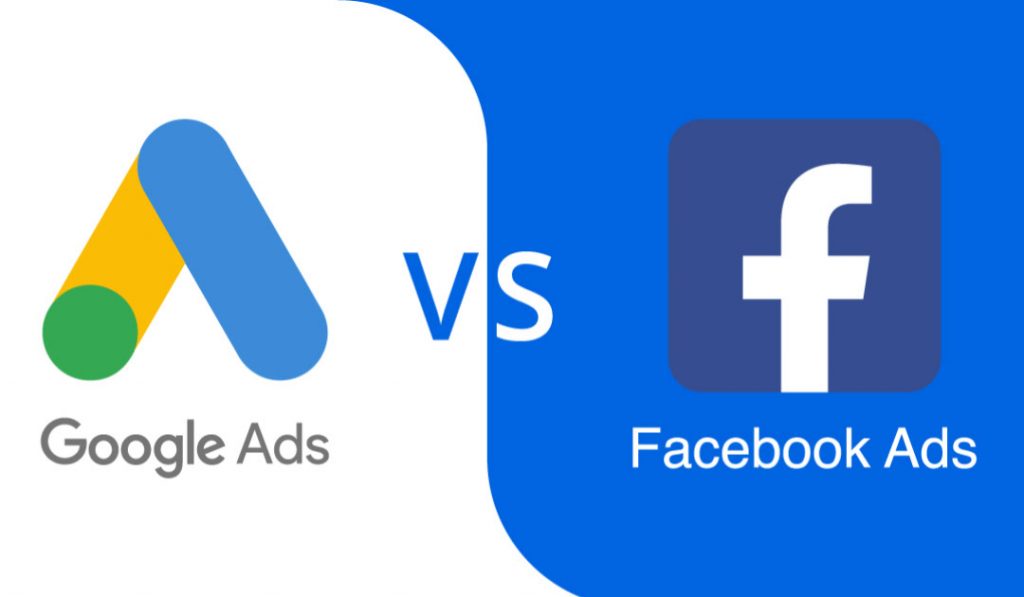
If you’re looking to run pay-per-click ads, Google Ads or Facebook Ads are the most popular platforms. Learn more about when to use each option.
When spending money on pay-per-click (PPC) advertising, you want the greatest return on investment (ROI). So you’re likely evaluating which platform is better to get started with online ads.
If you’ve run ads on either platform historically and seen few results, it could be because you didn’t target the ads correctly or set them up in a way that compelled your target audience to take a certain action.
Using these ad platforms seems simple enough on the surface, but in reality, there is a large learning curve. And it’s a big reason why companies hire a PPC expert to guide them along the way. Learn more about digital advertising and how to pick between Google Ads and Facebook Ads.

Generally speaking, Google Ads are an excellent choice for products and services that your target audience is actively seeking out. For example, home services do well on Google because people are often looking for a handyman, roofing contractor, etc.
Facebook ads are good for advertising products that your target audience is not actively searching for. But seeing an ad might spark their curiosity and suddenly make them wonder if they do need the product. For example, consumer electronics or housewares are goods that a consumer might not necessarily need right that moment but might consider purchasing after seeing an ad.
Let’s take a deeper look at each platform to better understand how to best use them based on the circumstances.
Average cost per click: $1-$2
User intent: Users are actively searching for answers to questions and products or services to purchase. They might have a brand in mind or be searching generically for information about their needs.
Audience targeting: You can target Google audiences based on the following.
Ad types: Call-only, text, shopping ads
Average click thru rate: 2%
Average conversion rate: 3.48%
When to use Google Ads: Increasing sales for products and services that customers are actively searching for. Concise ad copy is important and helps reach these engaged searchers who match your target audience. Getting in touch with your company quickly for more information will help the customer find you and reach you quickly.
Average cost per click: $.97
User intent: Users are passively scrolling through posts from friends, family and coworkers for entertainment. But they might be open to learning more about a. product, service or brand offering a product or service tailored to their needs.
Audience targeting: The targeting options here tend to be more comprehensive than Google. You can target Facebook audiences based on:
Ad types: Image, carousel, video, slideshow, collection
Average click thru rate: .89%
Average conversion rate: 9-10%
When to use Facebook Ads: Building awareness for products and services that your target audience may or may not need. The viewer has likely never heard of your product or service, or if they have, they haven’t considered buying it. Ads enable you to introduce your product or service in attractive ways through engaging images, videos, and other visuals.
Now that you have a good understanding of the use cases for each platform, learn more about how each of these platforms works. In short, Facebook Ads target users based on what they’ve shared about themselves on the platform and the types of content they historically enjoy viewing. Google Ads target users based on target keywords they are entering into the search engine.
Facebook is a social media platform. You’ll find 2.9 billion users on Facebook. When you’re running ads, you’re reaching your target audience based on their interests, demographics and other pages or types of content the user has engaged with.
While creating your ad, you’ll have the opportunity to choose an ad budget, where you’d like the ads placed and how long the ads will run.
The main benefit of Facebook Ads is that you’re reaching an audience who isn’t aware of your product or doesn’t know they want it yet. That passive advertising works well for non-essential consumer goods.
But the largest challenge in running effective Facebook ad campaigns is getting the targeting just right. While you have plenty of options, figuring out which is best will be somewhat challenging.
Conversion rates can be quite high though when you do get your audience target right even though Facebook Ad viewers do not have the same buying intent as Google Ad viewers.
Most users find Facebook Ad Manager easy to use and don’t face any challenges with creating their ads. What they don’t realize is that they aren’t fully optimizing these ads or getting specific enough about who their audience is to make the ads pay off. That’s why many brands abandon Facebook Ads believing they are not effective.
In contrast, Google is a search engine where users go for information instead of entertainment. Google dominates the search engine market with more than 86 percent of the market share. Google Ads are displayed at the top of the page in a similar format to organic results. Those ads are based on the keywords that the advertiser chooses.
Here, users are actively searching for answers to questions and specific products, services or brands. Because they are actively seeking out these things, it can be easier to convince the consumer to purchase with you.
Products that are easy to explain the benefits of tend to work best on Google ads because there is such limited space and no visuals to go along with the ad copy. You’ll need to use simple, actionable language to earn conversions.
Getting started with Google Ads is simple as all you have to do is create a Google Ads account. You’ll target your ads based on search terms or keywords.
For beginners, Google Ad Manager is not considered intuitive and easy to use. You’ll need some understanding of how keyword matching works to avoid showing your ads for irrelevant users, which will drive up your cost per click and drive down conversion rates.
While you can take a certification course with Google, this still only provides some general targeting insights and not the kind of in-depth understanding that leads to the best results.

Finding which ad platform is best for you will vary depending on what you’re advertising and who your audience is. But generally speaking, Facebook Ads cost less per click while Google Ads have a higher conversion rate.
That’s why Facebook Ads are well-known for their ability to bring awareness to a product or service but not necessarily known for incredible sales rates. Google Ads are an effective way to capture leads from interested parties prepared to buy while Facebook Ads help users get to know you to hopefully purchase with you later.
For pay-per-click expertise, schedule a free consultation with New Light Digital, a full-service digital marketing team committed to helping you see the best results from your advertising.
Further reading: